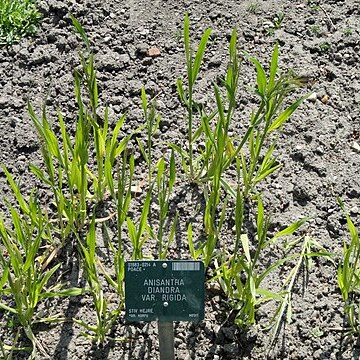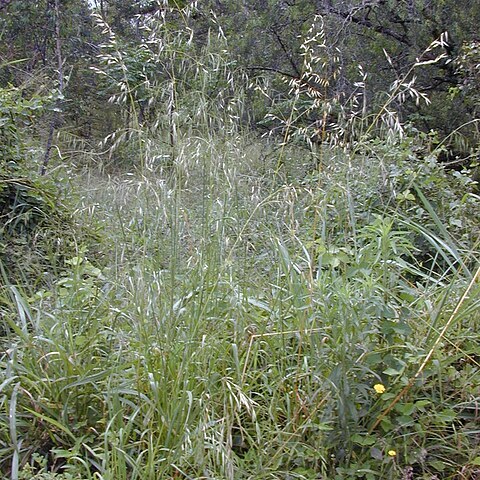Annual 3–8 dm; culms smooth; sheaths and blades pilose, the blades 3–6 mm wide; ligule 2–4(–5.5) mm; infl relatively long, 1–2 dm, with erect or spreading branches (or the lowest reflexed) each bearing 1 or 2 4–7-fld spikelets 30–40+ mm (to 9 cm incl. the awns); glumes subulate, the first 13–20 mm, 1(–3)-veined, the second 20–30 mm, 3-veined; lemmas subulate, 22–30 mm, 5-veined, scabrously short-hairy, 1–1.5 mm wide in side-view, the scarious teeth 3–6 mm; awns (30–)35–60 mm; palea shorter than the lemma; anthers 0.7–1.5 mm; 2n=28, 42, 56, 70. Native of the Mediterranean region, now widely intr. in w. U.S., and casually adventive in our range.
Loosely tufted annual, 400-700 mm high. Leaf blade 50-150 x 3-7 mm; ligule an unfringed membrane. Inflorescence a contracted panicle; pedicels hispid to villous. Spikelet 15-25 x 2-6 mm (excluding awns); glumes unequal, shorter than spikelet; lower glume 1-nerved, upper 3-nerved. Florets 4-many; lemma 20-25 mm long, apex acute, distinctly lobed, awn 30-50 mm long; palea ciliate on and rarely hairy between keels; ovary with a conspicuous hairy appendage at apex; anther 0.5-0.7 mm long. Flowering time Sept., Oct.
Loosely tufted annual 400-700 mm high. Leaf blade 50-150 x 3-7 mm. Inflorescence contracted to sometimes open, pedicels and branches hispid to hairy. Spikelet 15-25 x 2-6 mm (excluding awns), narrow, ovate to linear; lower glume 1-nerved; upper 3-nerved; lemma 20-25(30) mm long, apex distinctly bifid, acute, awns 30-50 mm long; palea ciliate on keels, rarely hairy between keels; callus scar elliptical, hairy; anthers 0.5-0.7 mm long.
A grass. It grows each year from seeds. It forms tufts. It is erect and 20-70 cm tall. They are hairy. The leaf sheaths have spreading hairs. The leaf blades are 10-25 cm long by 4-6 mm wide. They are hairy.
Like B. diandrus and often hybridising with it, but panicle usually dense, lemma callus pointed.


